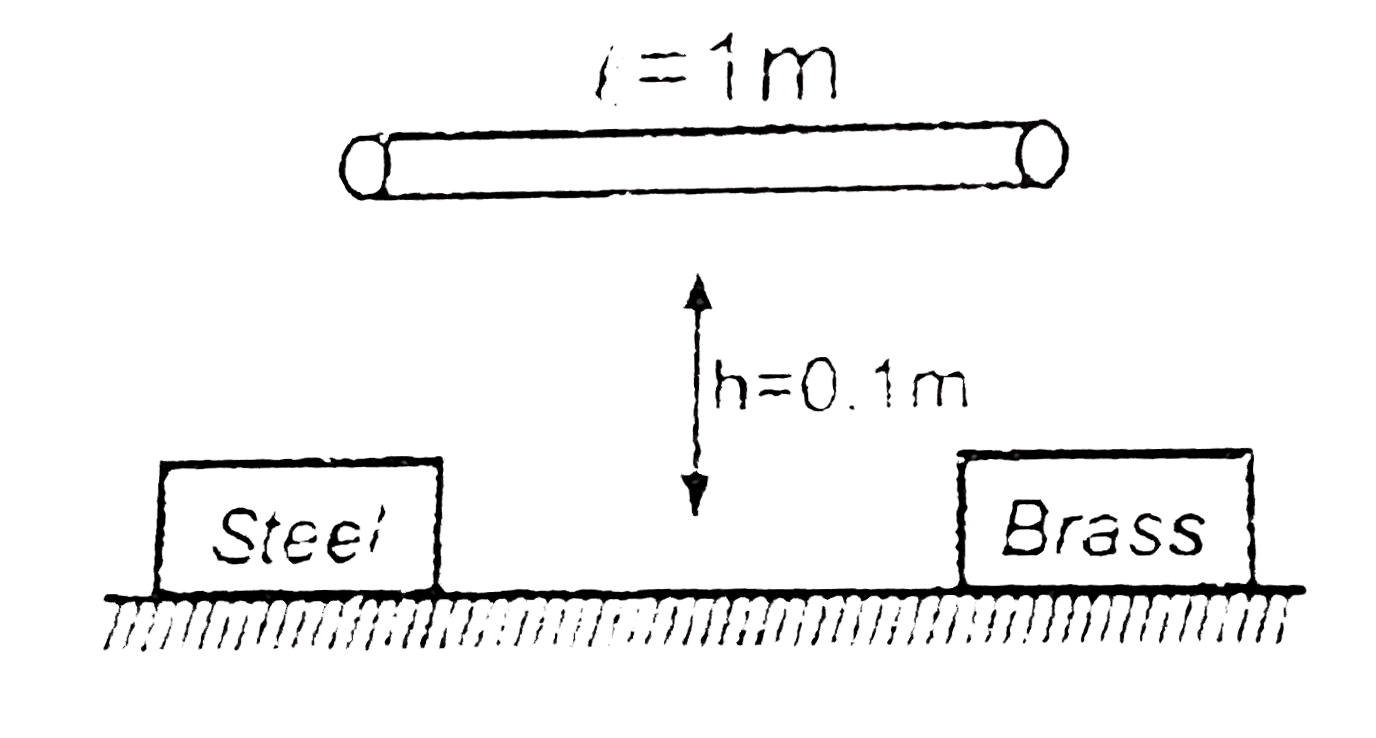A ball is dropped on a horizontal surface from height h. If it rebounds upto height h2 after first collision then coefficient of restitution between ball and surface is
1√2
12
14
12√2
The correct Answer is:A
To find the coefficient of restitution (e) between the ball and the surface after it rebounds from a height of h2, we can follow these steps:
Step 1: Determine the velocity of approach (v_a)
When the ball is dropped from a height h, we can use the equation of motion to find the velocity just before it hits the ground.
Using the equation:
v2=u2+2as
where:
- u=0 (initial velocity, since the ball is dropped),
- a=g (acceleration due to gravity),
- s=h (distance fallen).
Substituting the values:
v2a=0+2gh
Thus,
va=√2gh
Step 2: Determine the velocity of separation (v_s)
After the ball rebounds to a height of h2, we can find the velocity just after it leaves the ground using the same equation of motion.
Using the equation:
v2=u2+2as
where:
- v=0 (final velocity at the maximum height),
- u=vs (initial velocity just after the bounce),
- a=−g (acceleration due to gravity, acting downwards),
- s=h2 (height reached after bounce).
Substituting the values:
0=v2s−2g(h2)
This simplifies to:
v2s=gh
Thus,
vs=√gh
Step 3: Calculate the coefficient of restitution (e)
The coefficient of restitution is defined as the ratio of the velocity of separation to the velocity of approach:
e=vsva
Substituting the values we found:
e=√gh√2gh
This simplifies to:
e=1√2
Conclusion
Thus, the coefficient of restitution between the ball and the surface is:
1√2
When the ball is dropped from a height h, we can use the equation of motion to find the velocity just before it hits the ground.
v2=u2+2as
where:
- u=0 (initial velocity, since the ball is dropped),
- a=g (acceleration due to gravity),
- s=h (distance fallen).
v2a=0+2gh
Thus,
va=√2gh
After the ball rebounds to a height of h2, we can find the velocity just after it leaves the ground using the same equation of motion.
v2=u2+2as
where:
- v=0 (final velocity at the maximum height),
- u=vs (initial velocity just after the bounce),
- a=−g (acceleration due to gravity, acting downwards),
- s=h2 (height reached after bounce).
0=v2s−2g(h2)
This simplifies to:
v2s=gh
Thus,
vs=√gh
The coefficient of restitution is defined as the ratio of the velocity of separation to the velocity of approach:
e=vsva
Substituting the values we found:
e=√gh√2gh
This simplifies to:
e=1√2
Thus, the coefficient of restitution between the ball and the surface is:
1√2
Topper's Solved these Questions
- WORK, ENERGY AND POWERBOOK - AAKASH INSTITUTE ENGLISHCHAPTER - WORK, ENERGY AND POWEREXERCISE - Assignment (SECTION - A)
64 Videos
- WORK, ENERGY AND POWERBOOK - AAKASH INSTITUTE ENGLISHCHAPTER - WORK, ENERGY AND POWEREXERCISE - Assignment (SECTION - B)
35 Videos
- WORK, ENERGY AND POWERBOOK - AAKASH INSTITUTE ENGLISHCHAPTER - WORK, ENERGY AND POWEREXERCISE - SECTION-J (AAKASH CHALLENGERS QUESTIONS)
14 Videos
- WAVESBOOK - AAKASH INSTITUTE ENGLISHCHAPTER - WAVESEXERCISE - ASSIGNMENT ( SECTION-D ( Assertion - Reason Type Questions ))
12 Videos
Similar Questions
Knowledge Check
A ball is dropped on to a horizontal plate from a height h = 9 m above it. If the coefficient of restitution is e=1/2, the total distance travelled before the ball comes to rest is
A10 mB15 mC20 mD25 m
Two steel ball of equal diameter are connected by a rigid bar of negligible weight of shown and are dropped in the horizontal position from height h above the heavy steel and brass plates. If the coefficient of restitution between the ball and steel base is 0.6 and that between the other ball and the brass base is 0.4. the angular velocity of the bar immediately after rebound is _____ Assume the two impacts are simultaneous (g=10m/s2)

View SolutionA ball is dropped from height 5m. The time after which ball stops rebounding if coefficient of restitution between ball and ground e=1/2, is
View SolutionTwo identical balls are dropped from the same height onto a hard surface, the second ball being released exactly when the first ball bollides with the surface. If the first ball has made two more collisions by the time the second one collides. Then the coefficient of restitution between the ball and the surface satisfies :
View SolutionA 1.0 kg ball drops vertically into a floor from a height of 25 cm . It rebounds to a height of 4 cm. The coefficient of restitution for the collision is
View SolutionA metal ball falls from a height of 1m on to a steel plate and jumps upto a height of 81 cm. The coefficient of restitution of the ball and steel plate is
View SolutionA ball is dropped on a smooth inclined plane and is observed to move horizontally after the impact. The coefficient of restitution between the plane and ball is e. The inclination of the plane is
View SolutionA rubber ball is dropped from a height of 5 m on a plane. If bounces back to a height of 1.8 m. Find the coefficient of the resitution for the collision.
View Solution
